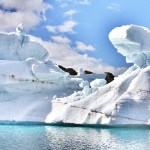glaciers
Snow. Glaciers. Icecaps, River flows. All of these are vulnerable to climate change, especially rising temperature. This isn't just theory. It’s now observable fact.
Scientists worry about the growing threat of climate change because the global climate is tied to everything that society cares about: human and environmental health, food and industrial production, water availability, extreme events, and more. Figuring out how all these pieces tie together is difficult. And many of us, from scientists to the public to policy makers, have only a partial understanding of the true…
The latest in a long series of science summaries on climate change from the Intergovernmental Panel on Climate Change (IPCC) has just been released. While the report has a massive amount of information in it, related to a wide range of geophysical implications of climate change, here are some of the key water-related findings for precipitation, evaporation, glaciers, ice mass, and more. While many other findings are reported that have hydrologic implications (such as all the findings related to temperature and warming), I have not usually included them here. Definitions of the confidence of…
Most of the current models of glacial ice melting (and contribution to sea level rise) focus on ice melting and less than they need to on the process of glaciers falling apart in larger chunks such as ice bergs. Also, current understanding of glacial ice melting due to global warming indicates that the Western Antarctic Ice Sheet (WAIS) is more vulnerable to melting over coming decades or centuries than is the Eastern Antarctic Ice Sheet (EAIS). New research from two different teams seems to provide a major corrective to these assumptions.
First, about how glaciers turn into ocean water.…
A paper came out in today’s Nature about glacial melting and its contribution to sea level rise. This paper does not present new research, but rather summarizes and evaluates the last several years of research on modeling and measuring contiental glaciers and their dynamics.
From the Abstract:
Since the 2007 Intergovernmental Panel on Climate Change Fourth Assessment Report, new observations of ice-sheet mass balance and improved computer simulations of ice-sheet response to continuing climate change have been published. Whereas Greenland is losing ice mass at an increasing pace, current…
One of the reasons that climate change is such a big issue is because the global climate is an integral part of the Earth’s entire ecosystem, tied to so many of the big and little things that society cares about. Figuring out how all these complicated pieces tie together is hard, as is linking these pieces together in the minds of the public so that we – and our policy makers – can grasp the true implications of a changing climate and plan for them. Because this is so important, I expect that many of my future posts here will address this issue, but let me start with one example: the…
Peter Sinclair has posted the second of a two part series documenting a trip he took with Mauri Pelto into the wilderness of the Pacific Northwest's Cascade range of mountains. Below are both part one and two of that series.
Reader enragedparrot asks the rather sensible question, which appears to have been somewhat neglected in the vast war of words of 2035, 2350, and quite what is the source for what: if 2035 is badly wrong, what is the right date?
The answer, of course, is that I don't know. But I may be able to tell you something useful along the way. If you've seen a better answer, please point me at it.
[Dragged from the comments: http://web.hwr.arizona.edu/~gleonard/2009Dec-FallAGU-Soot-PressConference-Backgrounder-Kargel.pdf is excellent -W]
So (forgive me, to clear more wrong stuff out of the way) 2035 is…
This is just one of dozens of responses to common climate change denial arguments, which can all be found at How to Talk to a Climate Sceptic.
Objection:
A few glaciers receding today is not proof of Global Warming, glaciers have grown and receded differently in many times and places.
Answer:
Firstly, it is more than "a few glaciers" that are receding, it is a pervasive, sustained and accelerating global trend. The National Snow and Ice Data Centre (NSIDC) maintains a chart of global glacier mass balance, and for as far back as their data allows us to look, all but a few years have…
